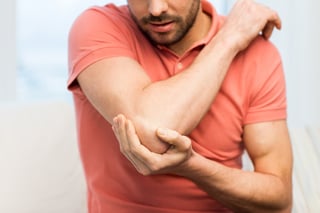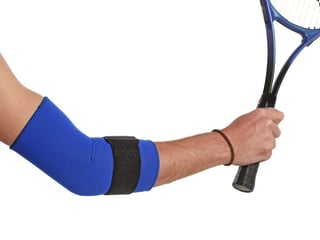Tennis injuries: most common, how to prevent, therapies for
July 7th, 2016 | 5 min. read


Tennis is a relatively safe, low-impact sport that is popular with people of all ages. However, tennis injuries can happen to anyone. Some of the most common injuries may surprise you.
Most common tennis injuries
Tennis elbow

Tennis elbow is probably the first injury to come to most people's minds. The official name for this overuse injury is lateral epicondylitis, referring to inflammation in the tendons and muscles surrounding the elbow joint, usually at the outside of the elbow.
Poor technique or bad equipment (like a loosely strung racket) can make tennis elbow more likely.
The main symptom is pain in the elbow or in the forearm close to it, which can worsen when bending the wrist or straightening the fingers. You might also notice discomfort when gripping objects, opening jar lids, or shaking hands.
Achilles tendon injuries
- Achilles tendinitis and tendinosis. If you notice your Achilles tendon feels tight or sore during or after a match, you may be experiencing inflammation. Achilles injuries can result from overuse, age-related degeneration of tissue, tight calf muscles, taking certain medications, or exercising while wearing insufficient footwear. The symptoms of injury include soreness, swelling, and limited motion in the ankle.
- Achilles tendon tears. A full or partial rupture of the Achilles tendon is a painful, acute injury that can "drop you" in the middle of a game. It's most likely caused by a sudden pushing off or twisting motion, though underlying conditions (such as taking certain medications) can also contribute to a rupture. If you tear your Achilles, you may hear a pop at the time of injury. Achilles ruptures sever the tendon connecting the calf muscle to the heel. In the case of a full rupture, you will not be able to raise your heel or stand on tiptoe.
Ankle sprains
In tennis, ankle sprains are common when players "roll" their ankles (inward or outward) or fall down when playing on uneven ground. Sudden starts, stops, and pivots may also gradually wear away the ligaments, causing pain and tenderness.
Technically, sprains are injuries to the ligaments of the ankle, and they can range from a minor overstretching of the tissue to a partial or complete tear.
Symptoms of an ankle sprain include pain, swelling, limited mobility of the joint, and difficulty standing or walking on the affected foot. Some people also experience bruising within the first 24 hours after injury.
Calf and hamstring strains
Muscle strains are the most common of all sports injuries, and tennis players are not immune. When muscles are stretched past their limits or normal range of motion, they can strain (commonly referred to as a "pulled muscle").
- Calf strain. The main symptom of a calf strain is a sudden pain that gets worse when you stretch the calf or straighten your leg. Serious strains can limit your ability to walk, stand on tiptoe, or put weight on the leg. Bruising is also possible.
- Hamstring strains. These often happen when making fast movements, such as sprinting to get to the ball. As with a calf strain, you may have trouble straightening the leg or bearing weight, and bruising can occur within 24 hours.
Knee injuries
Because tennis involves so many lateral movements, sudden sprints and stops, bouncing motions (when serving), and changes in direction — especially when playing on a hard court — knee injuries are quite common. Common knee injuries in tennis include:
- Jumper's knee. This anterior knee pain (pain in the front of the knee joint) is usually caused by tendinitis of the patella. Symptoms include swelling and a pain that is worse when the knee is bent or when pressure is applied to it.
- Chondromalacia. Pain in the front of the kneecap can also be caused by a gradual breakdown of cartilage. Unlike tendinitis, this condition is irreversible.
- Meniscus tears. Damage to the cartilage "shock absorbers" of the knee can cause pain and instability in the joint. Meniscus injuries are often the result of quick directional changes.
- Torn knee cartilage. Articular or meniscal cartilage tears can happen abruptly or over time, leading to pain, swelling, clicking sounds, or difficulty using the knee joint.
Less frequently, tennis players (particularly female athletes) may experience ACL tears, which are most often acute injuries that happen when landing, pivoting, or changing directly quickly when the foot is planted.
Stress fractures (pain in the feet, shins, or lower back)
This repetitive strain injury to the bone is actually a tiny crack caused by repeat impact against a hard surface.
Tennis players are most likely to sustain stress fractures to their shins, feet, or the last five vertebrae of the lower back. The main symptom of a stress fracture is a dull ache in the injured area. You're most likely to sustain a stress fracture if you play on a hard surface, if you play very hard and aggressively, or if you have osteoporosis.
- In the feet, you may experience swelling and tenderness.
- In the lower back, your pain may worsen when you bend forward or backward. (Osteoarthritis may also be the cause of dull, chronic pain in players who are middle-aged or older.)
Shoulder injuries
Shoulder soreness is one of the most common injuries affecting tennis players. Over time, making overhead serves and slams can put pressure on the muscles, ligaments, tendons, and nerves of the shoulder joint, leading to:
- Rotator cuff tendinitis. Inflammation of the tendons surrounding the rotator cuff can lead to symptoms like pain in the shoulder, swelling, and difficulty raising the arms over the head.
- Rotator cuff tears. A tear or degeneration of muscle or tendon can limit motion and cause near-constant, recurring pain. Symptoms include soreness and limited motion of the shoulder.
- Impingement syndrome. The catching of inflamed tendons in the subacromial space of the shoulder joint can lead to pain, tenderness, and difficulty raising the arms over the head or reaching backward.
Wrist injury: carpal tunnel syndrome
Gripping your tennis racket and bending your wrist can, over time, lead to pain and numbness, most commonly carpal tunnel syndrome. Inflammation in the carpal tunnel can put pressure on the medial nerve that controls sensation in the hand and fingers.
Symptoms can include tingling or numbness in the thumb, middle finger, and index finger. Bending all the fingers may become difficult, and you may struggle to grip objects.
tennis injury prevention

One of the best ways to lower your risk of tennis injury is to find ways to reduce the impact of the sport on your body.
- Play on a softer court with give (avoiding harder, more punishing surfaces like cement or asphalt).
- Invest in a good pair of tennis shoes with support or padding. Arch and heel support can go a long way toward protecting your feet and ankles from injuries like sprains, strains, Achilles tendinitis, and plantar fasciitis.
- Wear shoe inserts or specially padded tennis socks to provide extra cushioning. These small changes can help to absorb impact and protect your lower back from soreness.
- Check your equipment. A poorly-strung racket or wet ball can result in wrist injuries, forearm soreness, or tennis elbow.
As with all sports endeavors, however, you are the best way to protect yourself from injury. Be mindful of how you use your body before, during, and after you play tennis.
- Warm up your muscles before a match (for example, by walking or with dynamic exercises like arm circles, high knees, or jumping jacks).
- Use proper technique. A tennis instructor can help you focus on correct form when hitting, serving, and moving around the court (be sure to mention any prior injuries so you can learn how to protect them from re-injury).
- Learn how to condition your body to avoid injury. Some orthopedics centers offer knee conditioning programs, shoulder conditioning programs, and ACL awareness programs that focus on prevention and strengthening.
- Cool down your muscles and stretch after you play, to keep flexible and to improve your biomechanics.
An ounce of prevention is worth a pound of cure, as they say — but if you do get injured playing tennis, here are some of the treatments that may help.
TENNIS INJURY therapies
For less severe injuries like tendinitis, RICE therapy (rest, ice, compression, and elevation) can be helpful in easing your symptoms and allowing your body to heal itself.
Depending on the location and severity of your injury, you may also want to talk to an orthopedist about the following treatments:

- orthotics or shoe inserts
- a supportive brace or sports tape
- immobilization of your injury with a cast or boot
- sports medicine or physical therapy
- fracture care treatment (including bone growth stimulation)
- platelet-rich plasma therapy
- surgery to repair your joints, tendons, ligaments, or nerve impingement
If you have pain or mobility issues from playing tennis, give Coastal Orthopedics located in Corpus Christi, TX a call. Our orthopedic specialists can examine you, assess your condition, and discuss treatment options. Telephone: 361.994.1166.
Article written by: Rob Williams, MD
Dr. Williams has been practicing orthopedic surgery in Corpus Christi since 1998. After graduating from Texas Tech hereceived his medical degree from the University of Texas at San Antonio. At the prestigious Campbell Clinic located at the University of Tennessee, Dr. Williams completed not only an Orthopedic Surgery Residency, but an additional year of Fellowship Training in Spine Surgery. Dr. Williams is dedicated to creating an excellent patient experience in the office or in the surgery suite.
Topics:

